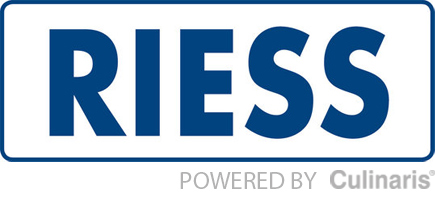Use & Care
Here are tips on how to use and care for your enamel tableware so that you can enjoy it for longer.
In addition to instructions for use, videos show "How to RIESS" what needs to be considered when using and caring for your Ries Enamel tableware.
Cooking with porcelain enamel
Enamel cookware can be used for all stove types (except the microwave) and is perfectly suited for induction stoves due to the magnetisable iron core.
Enamel tableware not only heats up very quickly due to its iron core, but also retains the heat perfectly. It is therefore good to start the cooking/frying process at a medium heat, turn it up slowly and then reduce the heat again. This prevents the cookware from overheating, which causes burning. You cook healthier, preserving the flavours and ingredients as a result.
- NEVER heat the cookware without any contents, this may cause the base to warp.
- Always choose the hob with the most suitable diameter – never a hob that is too small.
- Always heat up the cookware gradually. Start at a medium (not the highest heat or the boost function with induction stoves) and then turn up the heat.
- Turn off the hob 5-10 minutes before reaching the end of cooking time so that you can use residual heat to gently finish cooking.
- NEVER leave the frying process unattended. Oil can catch fire, cookware can become overheated, and the food can burn. May pose a danger to children.
- The recommended maximum operating temperature is 220 °C. This way, valuable nutrients and flavours are preserved.
Frying in the enemal pan
Enamel pans are all-rounders among pans with a long service life and are very popular with cooking enthusiasts. They are suitable for all fried dishes, from quick frying to slow braising. The heat is stored evenly throughout the entire pan - in the base and the walls - and is so good that the heat can be quickly adjusted downwards.
The bottom of the pan is always slightly curved inwards because it expands after heating and then lies flat on the hob. With enamel (= glass on iron), glass and iron show different expansion behavior. It is therefore important to start the frying process at medium and not at the highest level and then increase the heat. This allows both materials to expand evenly. You can find out more about this in the video and in our pan guide.
The five golden pan rules
1. choose and use correctly
- Select a pan that is appropriate for the dish and number of people.
- Follow the instructions for use of the stove and pan
- Before first use, remove sticker and rinse carefully.
2. Heat gradually and do not overheat
- Choose a hob that has the right diameter, but never a hob that is too small. NEVER heat the pan empty or unfilled.
- Distribute the fat evenly and heat it gradually, always starting with a low setting until the pan has warmed up all around and then increasing the power. Never use the boost function on induction cookers.
- The right temperature has been reached when the fat moves in the pan like streaks. Now the heat can be reduced slightly again. Note: The optimal operating temperature is around 220°C depending on the grease used. If steam forms, reduce the heating level immediately.
3. constantly observe
- NEVER leave the frying process unattended: oil can catch fire (if there is an oil fire, NEVER extinguish it with water), the pan can overheat and the food can burn.
4. Clean by hand
- To ensure you enjoy your pan for a long time, we recommend manual cleaning, our enamel care and the right cleaning aids. You can find out more under Care and Cleaning.
5. store carefully
- Hang up or insert kitchen paper or pan protector when stacking.
Baking in enamel
With enamel baking pans you can achieve perfect, hearty, crispy baking results because the heat is transferred perfectly through the iron core.
Enamel baking molds are also cut and scratch-resistant, which means cakes, tarts, etc. can be cut directly in the mold. The non-porous, smooth surface also makes cleaning incredibly easy.
Enamel bowls and bowls are also very suitable as helpers when stirring and kneading dough, as the glass surface preserves the aromas and everything is very easy to clean after kneading.
Baking instructions:
- Knead or stir all the ingredients in the enamel bowl or in the traditional Weitling.
- Now brush the inside of the baking tins with butter, then sprinkle them with breadcrumbs and now fill in the dough. This saves the use of baking paper. The baked goods can still be easily removed from the mold after baking.
- After baking, turn the warm dish out and cover it with a wet tea towel. After a short time, the baked goods will come out of the mold on their own.
- Due to the good heat conduction of the iron core, the baking temperatures can be lower or reduced more quickly than with other baking pans, depending on the type of stove.

